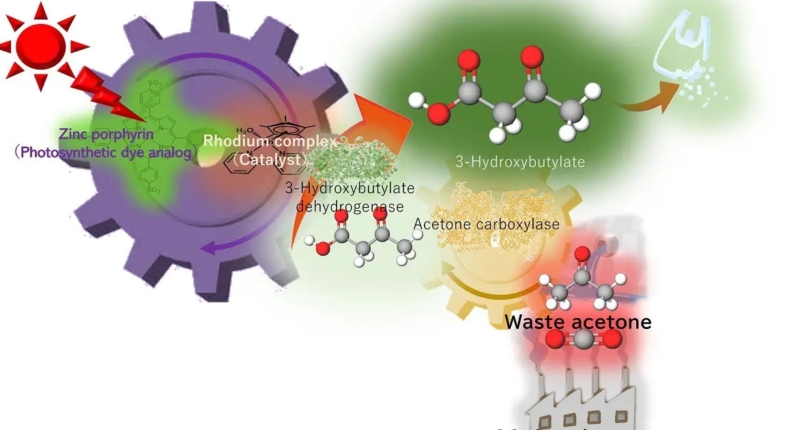A research team from Osaka Metropolitan University led by Professor Yutaka Amao has successfully repurposed waste acetone and low concentrations of CO2 using artificial photosynthesis to create biodegradable plastic precursors. The team’s study aimed to demonstrate the practical application of using waste materials to create eco-friendly plastic. The researchers used enzymes and a rhodium catalyst to produce the biodegradable plastic precursor from the acetone and CO2, which were used as raw materials for artificial photosynthesis, powered by light energy equivalent to sunlight. The research shows that artificial photosynthesis technology can revolutionize recycling by transforming industrial waste into eco-friendly plastic, reducing the impact of plastic waste on the environment. The team’s future plans are to further develop the technology so that it can use waste acetone from liquid waste and laboratory exhaust gas as raw materials. The findings were published in the journal Green Chemistry, and the research was funded by the Japan Society for the Promotion of Science.
Artificial Photosynthesis: Repurposing Waste Materials to Create Biodegradable Plastic
A research team at Osaka Metropolitan University, led by Professor Yutaka Amao, has developed a process using artificial photosynthesis to transform waste acetone and low concentrations of CO2 into a biodegradable plastic precursor. The study aimed to demonstrate the practical application of using waste materials to create eco-friendly plastic through artificial photosynthesis.
Poly-3-hydroxybutyrate, a strong water-resistant polyester commonly used in packaging materials, is made from 3-hydroxybutyrate as a precursor. Previous studies have shown that 3-hydroxybutyrate can be synthesized from CO2 and acetone with high efficiency, but only at higher concentrations of CO2 or sodium bicarbonate.
The research team’s recent study focused on using waste acetone from permanent marker ink and low concentrations of CO2, equivalent to exhaust gas from power plants, chemical plants, or steel factories, to synthesize 3-hydroxybutyrate through artificial photosynthesis. This system uses enzymes and a rhodium catalyst to produce the biodegradable plastic precursor, using light energy equivalent to sunlight.
After 24 hours, the team successfully converted over 60% of the waste acetone into 3-hydroxybutyrate, demonstrating the practical application of artificial photosynthesis. The study, published in the journal Green Chemistry on March 1, 2023, highlights the team’s plans to further develop this technology for more efficient use of waste materials.
“This technology has the potential to revolutionize recycling by transforming industrial waste into eco-friendly plastic, reducing the impact of plastic waste on our environment,” explained Professor Amao.
Artificial Photosynthesis to Repurpose Waste Materials
Professor Yutaka Amao from Osaka Metropolitan University plans to further develop artificial photosynthesis technology so that it can use waste acetone and exhaust gas from the laboratory as raw materials to produce eco-friendly plastic precursors. The team’s recent study successfully demonstrated that low concentrations of CO2 can be used to synthesize poly-3-hydroxybutyrate, a biodegradable plastic, using artificial photosynthesis. The findings were published in the journal Green Chemistry on March 1, 2023. The research was funded by the Japan Society for the Promotion of Science.
Don’t miss interesting posts on Famousbio









